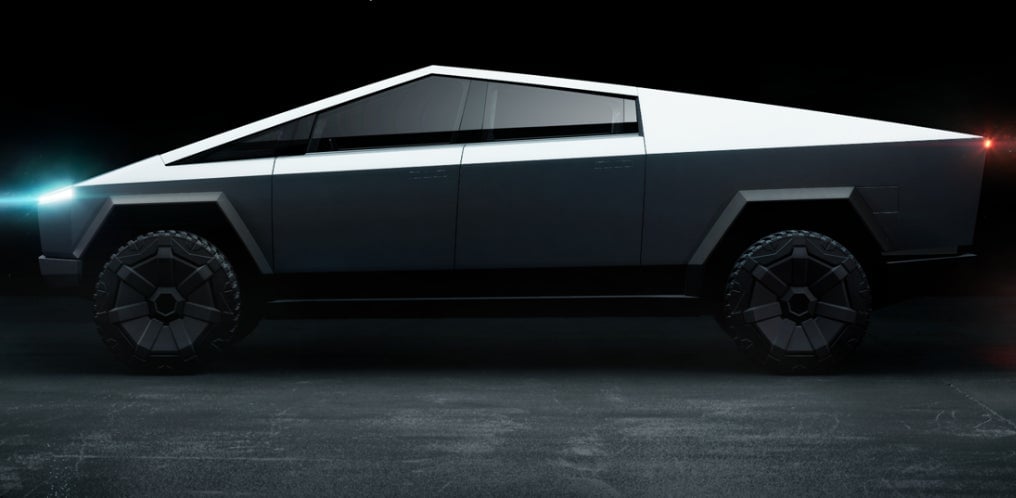Tesla’s new Cybertruck is here
Tesla’s Cybertruck is here, and it’s nothing like anything you’ve seen before. The angular armored pickup is the electric carmaker’s most unconventional vehicle to date, and its first entry into one of America’s most popular—and profitable—vehicle classes.


Tesla’s Cybertruck is here, and it’s nothing like anything you’ve seen before. The angular armored pickup is the electric carmaker’s most unconventional vehicle to date, and its first entry into one of America’s most popular—and profitable—vehicle classes.

The launch on Nov. 21 near SpaceX’s rocket factory in Los Angeles is key for Tesla. While not the life-or-death gamble of the Model 3, when the company’s solvency hung in the balance, Tesla needs to sustain its growth. Tesla has doubled down on the sedan and large SUV business, but Americans are abandoning the styles. Those vehicle segments represent just 6% share of vehicles sold in the US, according to a note analyst Adam Jonas of Morgan Stanley sent to investors Nov. 12, despite Tesla’s success with its Model S luxury sedan, and Model X SUV, and mid-priced Model 3 sedan.
In North America, pickups account for one of every six vehicles sold in the US (when including crossovers and SUVs, the share rises to 70%). Perhaps most important, pickups account for about 80% of the North American auto industry’s profits (and all of Ford’s and GM’s), Jonas noted. Today, pickup trucks are an $80 billion market segment, three times larger than the markets Tesla now competes in, according to Jonas’ note. “The pickup could be the hottest, fastest-growing [electric vehicle] in the US market over the next three to five years,” he predicted.
“We’re just doing an amazing pickup truck.”
Tesla CEO Elon Musk speaks of the new vehicle in nearly Trumpian terms, calling it better than Ford’s best-selling F-150. “I think the Tesla side of the truck is our best product ever,” Musk said in an October earnings call. Last year, Musk said it was an “amazing” produced he was most excited about. “I think that’s going to reach the next level stuff there,” he told investors.
Musk earlier teased a price around $50,000, above the median US pickup truck price of $45,260, according to the research firm J.D. Power and Associates. On Thursday, Musk unveiled three variations—with the lowest-end model coming in at just under $40,000, while the dual-motor version that can haul 10,000 pounds and has a range of 300 miles is around $50,000. That’s comfortably within reach of an increasingly luxury category which has seen median prices rise 40% since 2010 (the new Chevy Silverado pickup with High Country trim may go for $100,000).
Musk has touted its dual-motor all-wheel drive, “crazy torque,” dynamic suspension for heavy loads, all-day power for heavy tools, Autopilot, and a driver’s seat “big enough to fit André the giant.” The launch performance saw Tesla’s chief designer take a sledgehammer to the pickup’s armored doors, which didn’t leave a dent. (Another demo, hurling a steel ball at reinforced glass windows, was less successful.)
Those selling points, rather than its economy, could be wise marketing. For the vast majority of Americans, pickups are a lifestyle choice, not something they need for work. Businesses may use them on construction sites and for hauling loads, but 75% of truck owners drive off-road or tow something once per year or less, according to The Drive.
Not that this will sway Americans intent on buying trucks. No vehicle has identified itself as closely with the rugged individualist. With 80% of truck owners (almost 90% male) planning to buy another truck, it also has the highest loyalty rate of any vehicle category. Strategic Vision’s president Alexander Edwards told The Drive that truck buyers are most interested in the vehicles’ “ability to outperform others, to look good while driving, to present a tough image, to have their car act as an extension of their personality, and to stand out in a crowd.” That gives Tesla the chance to redefine the truck category with its cyberpunk, Blade Runner-inspired vehicle.
But Tesla’s rivals are not ceding the space: They’re already building electric entries for the early 2020s. GM said in an earnings call this October that it’s retooling its Detroit-Hamtramck plant to build an all-electric pickup truck and advanced battery system. “We believe in an all-EV future,” GM CEO Mary Barra said on the call. Electric truck startup Rivian is releasing its own R1T, a $65,000, 400-mile range pickup truck that promises to wade into water up to 3 feet deep. And Ford shot a commercial this year showing it can tow a 1 million pound train with its upcoming electric F-150.
But electric pick-ups, especially Tesla’s, will still have to prove themselves to traditional buyers. EVs are not a natural fit for traditional truck marketing. Only 8% of truck buyers rank fuel economy as a priority, and even fewer are willing to pay a premium for it. Some truck owners regularly brag about “rolling coal,” using modified diesel engines to blow plumes of black smoke at EVs, as well as “ICE-ing” (with ICE standing for internal combustion engine) out EVs by blocking their charging stations. Practical concerns will prove even more critical.
According to a Kelley Blue Book survey (pdf) of about 1,000 people last year, the number one factor truck buyers are looking for is reliability (about 30% of those surveyed), followed by value for money (16%). Tesla’s reliability ranking still leaves something to be desired, notes Consumer Reports. Tesla only just regained its “recommended” rating from the organization this year, but languishes in the bottom-third of brands for reliability due to early production struggles with the Model S, X, and 3 vehicles.
For now, most truck buyers aren’t even thinking about an electric powertrain. Kelley Blue Book’s 2018 survey revealed only 9% of buyers are considering a hybrid power train. The survey didn’t even ask about all-electrics. Perhaps Musk’s newest creation will change that.
Update: This story was updated on Nov. 21 with details from the launch event.